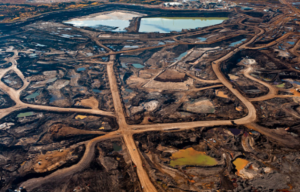*April 2018 marked the 400th consecutive month of global temperatures above the 20th century average. That heat is coming from burning fossil fuels, which are subsidized $5.3 trillion per annum.
Humans are knowingly pumping climate-damaging carbon dioxide into the atmosphere 10 times faster than the previous 66 million years.
All planetary biological systems are constrained by temperature. Rising temperatures and repeated prolonged heatwaves are deadly to both land and sea life.

Photo credit: priceofoil.org
Nowhere on land are the poisonous effects of burning fossil fuels more apparent than the Arctic region.
At Cape Morris Jesup, the northern most point of Greenland, in the month of February, since 1981, it has been rare for the hourly air temperature to spike above freezing. In 1997 it happened once. In 2011 it happened five times, and in 2017 it happened seven times.
This year, it has happened 59 times.
Unprecedented.
It’s not just heatwaves in the Arctic becoming commonplace that are distressing my colleagues. Warming in the winter has begun to impact ice growth during the winter. The growth of ice thickness over the Arctic Ocean, during the winter of 2016-17, was reduced by five inches.
What happens in the Arctic…doesn’t stay in the Arctic.”
Fossil fuel-driven heatwaves, drought and the ensuing onslaught of insects, are laying waste to our trees. Across America, its urban and wild forests are disappearing at a rate never witnessed before. Each year, American cities and towns are losing an area of urban tree cover that’s equivalent to about 175,000 acres. We are witnessing 36 million trees die each year. Hideous.
By the way, urban trees help cool our homes and schools by as much as 40 percent. Urban trees protect against storm water runoff damage, they save taxpayers millions of dollars. Urban trees also absorb mega tons of fossil fuel pollutants, which are known to cause Alzheimer’s disease in children.
The loss of trees, rising temperatures and increasing heatwaves led NASA to issue a dire global water shortage report. NASA found that burning fossil fuels were “clear human fingerprints” driving the climate crisis.
The deleterious effects of burning fossil fuels are felt in all four corners of the world.
On April 30, 2018, the mercury soared to 122.4 Fahrenheit (F) in the city of Nawabshak, Pakistan. It was a world record – the hottest temperature ever recorded in April.

Photo Credit: Twitter.com
That world record occurred after an extreme heatwave roasted parts of Asia. At least seven countries broke March’s monthly records: Pakistan 113.9, Iraq 110.8, Qatar 104, Turkmenistan, 104.4, Uzbekistan 99, Tajikistan 95.5 and the United Arab Emirates 109.6 (F).
On May 10, 2018, the capital city of the island state of Tasmania, Hobart, and nearby Mount Wellington experienced historic flooding. Hobart and its surrounding area received almost 130 millimeters, or 5.1 inches of rain, in 24 hours. Mount Wellington recorded an astonishing 236 millimeters, or 9.3 inches, over that same period. Record breaking floods, violent winds and more than 1,000 lightning strikes caused millions of dollars in damage to thousands of properties.

PHOTO CREDIT: THEAUSTRALIAN.COM.AU
Stoking the atmosphere with heat-trapping fossil fuels causes it to hold seven percent more moisture for each degree centigrade, which translates into more extreme flooding events around the globe.
Despite all the ominous scientific reports on the terrifying consequences of burning fossil fuels, the largest offenders, China and the United States, are increasing exploration, exploitation and construction of new fossil fuel plants.
This overt fossil fuel profiteering and its rapid destruction of our biosphere will lead to the collapse of civilization in the coming decade(s). This is insane!
#Resist
•••••••••••••••••••••••••••••••••••••••••••••
Dr Reese Halter is an award-winning broadcaster, distinguished conservation biologist and author.
Dr Reese Halter’s latest book is
Save Nature Now
Tweet @RelentlessReese
•••••••••••••••••••••••••••••••••••••••••••••












